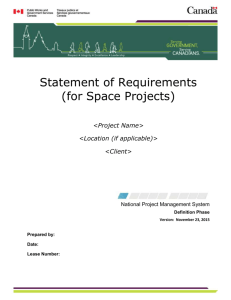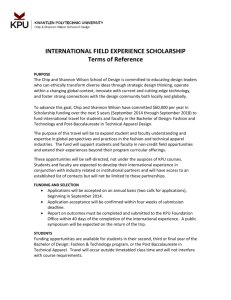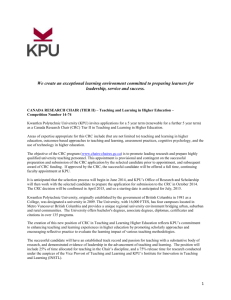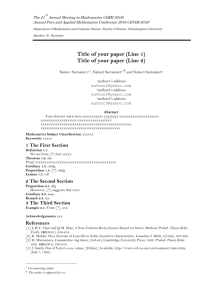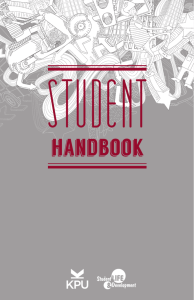“Guide for the Preparation of Investment Analysis Reports”.
advertisement
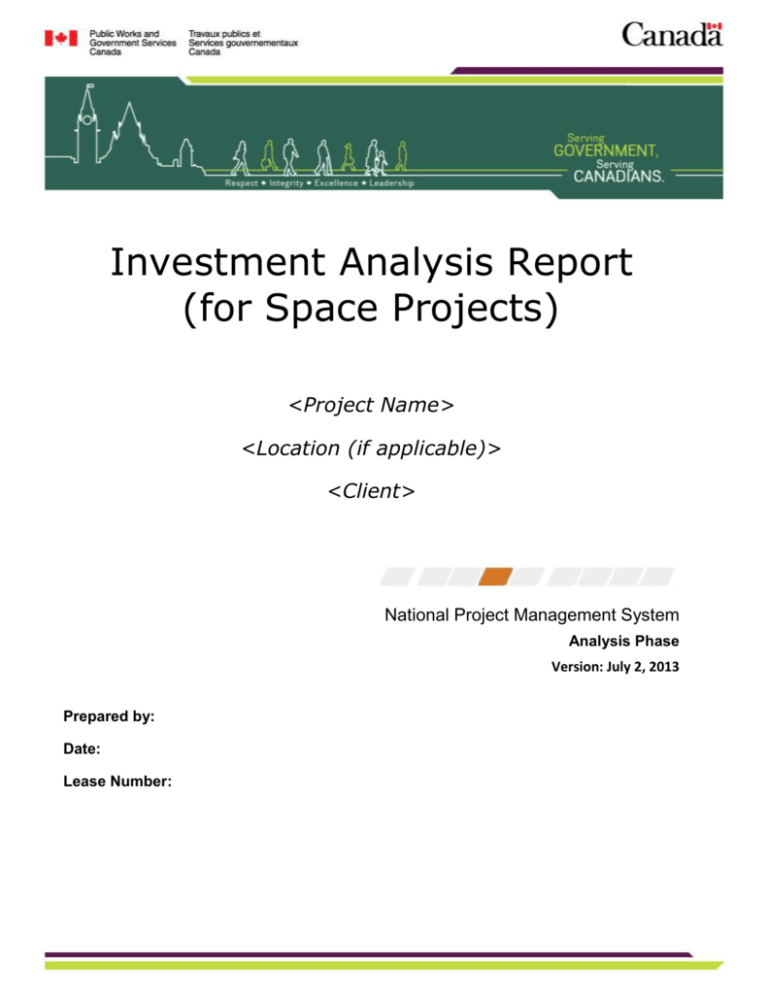
Investment Analysis Report (for Space Projects) <Project Name> <Location (if applicable)> <Client> National Project Management System Analysis Phase Version: July 2, 2013 Prepared by: Date: Lease Number: IAR Template for Space Based Projects Table of Contents Executive Summary ...........................................................................................................................................2 1. Problem/Opportunity Definition ...............................................................................................................2 2. Background ................................................................................................................................................3 2.1 Project History .........................................................................................................................................3 2.2 Building Condition....................................................................................................................................3 2.3 Tenant Considerations .............................................................................................................................3 2.4 Strategic Context .....................................................................................................................................4 2.5 Stakeholders ............................................................................................................................................4 3. Project Scope ............................................................................................................................................5 4. Identification & Analysis of Options ..........................................................................................................6 4.1 Options Considered .................................................................................................................................6 4.2 Non Feasible Options ...............................................................................................................................6 4.3 Feasible Options.......................................................................................................................................6 4.4 Financial Analysis .....................................................................................................................................6 4.5 Analysis of Non-Financial Factors ............................................................................................................7 4.6 Risk Assessment .......................................................................................................................................8 4.7 Conclusions ..............................................................................................................................................9 5. Strategic Impact .........................................................................................................................................9 6. Recommendation ................................................................................................................................... 10 7. Approval Authority and Funding............................................................................................................. 10 8. Implementation Plan .............................................................................................................................. 10 9. Project Team & Signatures ..................................................................................................................... 11 10. Appendices ......................................................................................................................................... 11 Appendix 1 – Financial Assumptions Summary Table .................................................................................... 12 1 IAR Template for Space Based Projects This template serves as a helpful tool for preparing an IAR. It does not replace the “Guide for the Preparation of Investment Analysis Reports”. The template has been approved by National Portfolio Management and the 2009 Guide is currently in the process of being updated. Executive Summary Maximum length of 2 pages 1. Statement of the problem/opportunity Problem/Opportunity definition 2. Previous Approvals, decision or agreements (if applicable) 3. Options analyzed - Results of financial analysis - Financial factors, include Table of PVCOA and risk-adjusted PVCOA (if applicable) - Non-financial and risk factors for best value approach 4. Estimated project cost - Risk allocation - HST/GST separate - Type of approval - Spending authorities (if applicable) - Appropriate delegated authorities - PCRA score - LCA amount including fit-up costs, O&M, taxes (if applicable) 5. Source of funding 6. Client costs (if applicable) 7. Special issues to Regional Investment Management Board/Real Property Investment Board (if applicable) Risk management Potential political consideration Timing Legal issues Client issues Department’s sustainable development targets Heritage conservation Public sensitivity Recent or ongoing related projects 1. Problem/Opportunity Definition 1. General Information Client requirement Occupancy Expiry Date New Acquisition Date Deadline to exercise lease option(s) (if applicable) Location of space (address) 2. Drivers Program requirements Current Accommodation not suitable (if applicable) Possible opportunities 3. Previous approvals, decisions or agreements: 2 IAR Template for Space Based Projects - 4. Real Property Investment Board (RPIB) Regional Investment Management Board decision (RIMB) Treasury Board approvals (TB) Cabinet or Ministerial decision Interdepartmental agreement Special Involvement of other departments Note: This section should not include any indication of the proposed solution. Its purpose is to concentrate on what drives the project. 2. Background 2.1 Project History 1. Description of tenants Short description of the relevant history of the client occupancy at this location Date when the client first occupied the space 2. Compliance with NPMS NPMS Checklist in the Appendix 2.2 Building Condition 1. Brief description of building Age, area , location, main characteristics, classification of the building, building owner History of occupancy (When did the federal government begin leasing in this building? How was this space acquired initially?) Environmental performance assessment (BOMA BESt, LEED, etc) 2. Overall condition Building Performance Report (Building-related problems and impacts) Recent renovations, refresh projects or tenant service projects, and fit-up condition Accessibility Report (if not available; must have a confirmation from Property Management on condition, and should include the estimated date that the report will be available) Lease Condition Report (LCR) (if not available; must have a confirmation from Property Management on condition, and should include the estimated date that the report will be available) 2.3 Tenant Considerations 1. Description of tenants Background information on tenants Inventory of current occupancies for Client Department Nature of program(s) that may be impacted by this requirement 3 IAR Template for Space Based Projects Inventory of current occupancies in the region1 Name or address Fontaine Monclair Saint-Joseph Vincent Massey Client Occupancy Start Date Apr. 1, 2009 May 1, 2010 May 1, 2010 Aug. 1, 2011 Expiry Date Lease Expiry Date Dec. 31, 2013 Mar. 31, 2013 Aug. 31, 2014 Mar. 31, 2016 Dec. 31, 2022 Apr. 30, 2020 Aug. 31, 2014 Jul. 31, 2036 Options Left 1 X 5Y Grand Total Office m2u 117.6 1,350.1 195.6 1,477.0 3,140.3 SPS m2r 129.2 1,357.9 225.9 2,429.0 4,142.0 m2u 752.8 752.8 m2r 884.3 884.3 Total m2r 129.2 1,357.9 225.9 3,313.3 5,026.3 Current client(s) occupancies affected by this requirement Note: for Special Purpose Space (SPS) and office, even if they are the same rate, they should always be shown separately Client Lease No OI Funding ABC 123456 4A0000 Non-reimbursing 123457 4A0001 Reimbursing Type of Space Office SPS Office Total for ABC FTEs m2u m2r Parking Occupancy Expiry 62 1,000.0 500.0 750.0 2,250.0 1,125.6 562.8 844.2 2,532.6 2 May 31, 2015 3 5 May 31, 2015 46 108 2. Impact of current problem/opportunity on tenants (if applicable) Additional tenant costs Disruption of Program Required relocation In-service date 3. Client liaison activities (if applicable) How client concerns are currently being dealt with 2.4 Strategic Context 1. Describe how the problem/opportunity relates to current strategies and plans National Investment Strategy (NIS) Regional Investment Strategy Community Based Investment Strategy (CBIS) Portfolio Strategy Strategic Action Plan Lease Action Plan Client Strategy (Explain the client’s long-term and short-term accommodation strategy) Government of Canada WP2.0 fit-up standards 2. Meet with Portfolio Management, Owner Investor Analyst, Asset Manager and any other relevant stakeholders, to ensure that all necessary background information is included; any additional directives from upper management, priorities, budget cuts, strategic and operating review, etc. 2.5 Stakeholders 1 1. List all the relevant stakeholders who have an involvement in the problem/opportunity 2. Briefly describe their stake This information is from the OI List. If relevant (i.e. consolidation), information should be provided 4 IAR Template for Space Based Projects 3. Project Scope 2 1. Requirements Space required : number of FTEs to accommodate, m2 of Special Purpose Space (SPS), m2 of storage (warehouse, training rooms, etc,) Type of space (identify if any non-compliant space or SPS was approved by PWGSC) Swing Space (if applicable) Geographical boundaries including justification of boundaries chosen 1. North : _________ 2. South : _________ 3. West: _________ 4. East : _________ - Identify the City and Province. Identify unique program and/or operational requirements that may further restrict the geographic boundaries as per the Geographic Boundaries Procedure. Date by which space is required Length of term as required by client 2. PWGSC Space Allocation Limits (see table below) Number of FTEs Space entitlement (m2u/ m2r) as per Space Allocation Limits (WP2.0) Ratio m2u/FTE (current vs. WP2.0) Determine if space is quasi-judicial; if yes, WP2.0 entitlement is different If client is above m2u/FTE target, justification is required Requirements for compliance to WP2.0 fit-up standards and exemptions (non-compliant space) Space Allocation Standards based on project requirement Client Type of Space FTEs X Office – General Administration Y Z Office – Public Contact Office – Quasi-Judicial Total Usable Area Required 183 Office 5 SPS 0 0 188 Space Allocation Limits (m2u) 2,429.12 Requested Space (m2u) Variance (+/-) Utilization rate (m2u /FTE) 2,430 0 12.92 0 0 2,429.12 0 0 2,430 0 0 n/a n/a 12.92 Office Space Calculator 3. Operational parking requirements (as per custodial parking policy) 4. Special considerations (if applicable) Specific location within a building (ground floor, retail space etc.) Specific type of location Security requirements (highly sensitive) Heritage building 5. Client demand forecast (if applicable) Factors influencing future demand Likelihood of factors 2 If a Client Accommodation Requirement Questionnaire (CARQ) and/or a Tenant Requirement Package (TRP) were filled-out, include them in the appendices. 5 IAR Template for Space Based Projects - Impact on client requirements Future changes in funding levels 6. Occupancy commitments (client commitment vs. lease term) 7. Impact on space envelope and source of client funding (ECF or Non-Reimbursing) 4. Identification & Analysis of Options The information in the following section should only summarize the key findings of the Feasibility Report and should be updated, if applicable. If the project qualifies for NPMS Lite (where a Feasibility Report is not required), all Feasibility Report information should be incorporated into this section. 4.1 Options Considered - Identify and describe all reasonable options for satisfying the project requirements 4.2 Non Feasible Options - Clearly explain why the eliminated options are not considered for further analysis 4.3 Feasible Options - Clearly explain why the retained options are being considered for further analysis 4.4 Financial Analysis 1. Availability of accommodation space Government inventory Local real estate market description (quarterly reports) 2. Real Estate Market Analysis Market information Market Survey Report (MSR) (include source of reports and effective dates) Market Analysis Report (MAR) (include source of reports and effective dates) Market Analysis Report; reference XXXXXX (date) Gross Effective Rental Range ($/m2r) $XXX - $XXX Estimated Base Year Taxes and Operating Costs Net Effective Rental Range Storage Space (Gross) Parking (per stall per month, including taxes) $XXX $XXX - $XXX $XXX - $XXX $XXX - $XXX - Classifications of comparable buildings surveyed (class A, B, or C) Vacancy rates Results of recent Generic Request for Information (GRFI) and Request for Information (RFI) that may apply to this project to confirm the supply Conclusion reached based on the analysis of demand and supply related to this project: Most probable availability of suitable space (description of the supply; class of building; anticipated rental rates used) 3. Financial Assumptions 6 IAR Template for Space Based Projects *Financial Assumptions must either be fully developed under each option wherever relevant or an individual section must be created before the Financial Analysis section. This information could also be put in an appendix. - Key input assumptions common to all options Detailed description specific to each option (in-service date, swing space, m2 for each option, description of delivery, LEED requirement, …) Additional notes where applicable Summary table for each option and source (refer to Appendix 1) ** REFIT calculations and detailed table of assumptions are always required. 4. Financial Analysis Full costs to the federal government for each option (PWGSC and client) All relevant costs (ensure valid assumptions and input values are realistic and supported by an explanation or a source) Results of financial analysis in table showing PVCOA for each option Options Option 1: ….. Option 2: …. PVCOA $ XXXX $ XXXX Rank 2 1 RA-PVCOA $XXXX $XXXX Rank 1 2 - Risk-based investment analysis (for projects with LPA > $30M only) Risk-neutral PVCOA and risk-adjusted PVCOA for each option in table form Explain the results Note: if a risk factor is quantified in the RA-PVCOA, do not include it in the Risk Assessment (Section 4.6) as it would then be double-counted - Conclusion Which is the most financially viable option? Do variations to key assumption make a difference (sensitivity analysis)? What conclusions can be reached? 4.5 Analysis of Non-Financial Factors 1. Advantage and Disadvantage Table (example) Option Option #1 Renewal In-Situ Option #2 Lease Tender Call 2. Advantages Benefit from client investments and current infrastructure No disruption to the tenants program delivery and services to Canadians Open transparent and competitive process Space alignment with OAF Disadvantages Non-competitive process Risk of not finding suitable alternative space Limited internal resources Disruption to client New fit-up required, longer project delivery timeline Include all relevant non-financial factors for each option. Some examples that can be used are the following: Project requirement satisfaction Client requirements satisfaction Strategic context Impact on diversity or balance of the inventory Timing requirements respected 7 IAR Template for Space Based Projects 3. Support goals and objectives of PWGSC Sustainable Development Strategy Suitability of accommodation Flexibility Ease of implementation Disruptions to tenants Strategic compatibility Good Neighbour Policy Environmental factors Federal presence Accessibility For projects that require National approval, also use an “Evaluation Matrix for Qualitative Analysis” Each factor should be explained Non-Financial Factor Weight Factor 1 Factor 2 Factor 3 Factor 4 Factor 5 Total Score 30 25 20 15 10 100 Option 1 Option 2 Option 3 Score Score Score 30 22 17 15 8 92 27 25 10 5 6 73 30 25 16 12 6 89 Note: not applicable if there is only one feasible option. 4. Description of results of analysis and conclusion reached for each factor (must justify ratings) 4.6 Risk Assessment 1. Evaluation of relative level of risk for each option (Evaluation Matrix for Risks) Risk Factors Client requirements not being met Changing client requirements Timing delays Cost increase Negotiation risk Market conditions Funding Lack of human resources TOTAL SCORE Option 1 I Score M 4 L 1 H 3 H 3 L 1 L 1 M 4 L 1 18 L M L L L L L M L L Option 2 I Score L Option 3 I Score Note 1: Table not applicable if there is only one feasible option. Note 2: For projects going to National, a 5x5 matrix (Very High-High-Moderate-Low-Very Low) is necessary. Impact (I) Legend: High (H) 3 3 6 9 Moderate (M) 2 2 4 6 Low (L) 1 1 2 3 1 2 3 Low (L) Moderate (M) High (H) Likelihood (L) 8 IAR Template for Space Based Projects 2. Example of risk factors relevant to each option Risk that the project may not fully rectify an identified problem Risk of user needs not being met Risk of changing requirements Risk of not meeting timing requirements Risk of cost overruns Risk of future performance being impaired Risk of environmental degradation 3. Explanation of the evaluation matrix per risk: Description of results 4. Conclusion of risk assessment : Which option carries lowest level of risk? How does each option rank in terms of risk? Do any of the options carry an unacceptable high level of risk? Briefly summarize key findings from the evaluation matrix 4.7 Conclusions Combination of results of all analysis (determine which option provides the overall best value to the federal government) Considering results, what conclusions can be reached? State why preferred option is better than the other options available Convey through the conclusion that the recommended option represents “best value” to the Crown, particularly when it may not be the “least cost” option Convey the risks of not proceeding with the recommended option to further articulate the need to implement the recommended option - 5. Strategic Impact 1. Identify strategic value of proceeding with the project 2. Demonstrate project is carried out in a manner consistent with departmental policies and strategies. 3. Use checklist of strategic and policy compliance table below. Apply it specifically to each individual project: Policy/Strategy Compliance Yes No Justification (always required) Workplace 2.0 Fit-up Standards Sustainable Development Strategy Good Neighbour Policy Community-Based Investment Strategy Strategic Action Plan Regional Portfolio Strategy Client Strategy 4. In Case of DIRECT NEGOTIATION for lease, identify whether or not the project meets with the ‘Six Principles of Direct Negotiation Lease Renewal’. - If not, identify why not and include a mitigation strategy if renewal fails In the Appendix, attach a detailed list of the Six Principles 9 IAR Template for Space Based Projects 6. Recommendation Maximum length of 2 paragraphs 1. Clear and detailed statement of the proposal being recommended for approval. Project definition Cost (HST, Class of estimate, LCA, Risk allowance) Timing Usable and rentable square meters (m2u, m2r) 2. Client costs (if applicable) - Related to above standard fit-up (included in LPA) and how they will be reimbursed - Furniture, Fixture & Equipment (FF&E) 3. Comments on urgency of project 4. Client agreement with proposed approach (statement) 5. Issues to be brought to the attention of RPIB or RIMB (decision makers) 7. Approval Authority and Funding 1. PCRA Score Date included on IIP list 2. Identify Delegated Approval Authority (DG, ADM, Deputy Minister, TB) 3. Source of funding (confirmation from CFO for client costs) 4. Projection of cash flows (in a table) 5. For projects that require National approval, detail cash flow table should be provided: 2012/2013 2013/2014 Project Cost $ XXXXX $ XXXXX Risk allowance $ XXXXX $ XXXXX Sub-Total Escalation GST/HST $ XXX $ XXX Total $ XXXXX $ XXXXX See detailed cost breakdown in Appendix 2014/2015 $ XXXXX $ XXXXX 2015/2016 $ XXXXX $ XXXXX Total $ XXXXX $ XXXXX $ XXX $ XXXXX $ XXX $ XXXXX $ XXX $ XXXXX 8. Implementation Plan 1. Include project schedule Key milestones for project Anticipated completion date Occupancy date Detailed project schedule attached in appendix 2. Risk Management Plan (attach as appendix) Identify key risks including summary of risk mitigation measures only for the recommended option 3. Include what type of lease will be used (if applicable – mainly for large projects) 10 IAR Template for Space Based Projects 9. Project Team & Signatures Position (examples) Project Director Senior Project Leader CASA/ Accommodation Manager Senior Project Manager Project Manager Prof. and Tech. Resources Senior Financial Advisor Property Manager Other (specify) Action Organization Date Name Signature Prepared by Project Leader Reviewed by Recommended by 10.Appendices Content varies depending on situation: 1. Financial Assumptions Summary Table 2. Detailed cost estimates for the proposed project 3. Space Calculation (summary page) 4. NPMS Feasibility Report (if separate document) 5. NPMS Compliance Checklist 6. Risk Management Plan 7. Summaries of building condition and building performance (LCR), if extensive 8. Project Implementation schedule 9. Communication Strategy 10. PCRA Summary Sheet 11. Six Principles of Direct Negotiation for Lease Renewal (if applicable) 11 IAR Template for Space Based Projects Appendix 1 – Financial Assumptions Summary Table Financial Assumptions Applicable to all Options Financial Item Source Assumption Escalator (%) – Rent % Finance’s month/year publication Escalator (%) – O&M % Finance’s month/year publication Escalator (%) – Taxes % Finance’s month/year publication Escalator (%) – Land % Finance’s month/year publication Escalator (%) – Service Fees % Finance’s month/year publication Escalator (%) – Construction & Systems % Finance’s month/year publication Option 1: Item Financial Assumption Option 2: Financial Assumption Source Source General Financial Assumptions Office space m2u / m2r m2u / m2r SPS space m2u / m2r m2u / m2r Storage space m2u / m2r m2u / m2r Parking stalls # of stalls # of stalls Fit-up/Refresh $/m2u Moving and signage $/m2u Consultant Disbursements Contingency Project Leadership fees Project Management fees Based on PWGSC’s FYXX/XX Fit-up standards Best practice $/m2u $/m2u Based on PWGSC’s FYXX/XX Fit-up standards Best practice % of fit-up Best practice % of fit-up Best practice % of fit-up % of fit-up, moving and signage, consultant and disbursements % of fit-up Best practice Best practice Best practice % of fit-up % of fit-up, moving and signage, consultant and disbursements % of fit-up % of fit-up Best practice % of fit-up Best practice Best practice Best practice Best practice LPA (2001L) Gross Rent Office & SPS space $/m2r n/a n/a Gross Rent Storage $/m2r n/a n/a O&M $/m2r n/a n/a Taxes $/m2r n/a n/a n/a n/a n/a n/a n/a n/a Parking rate Investment horizon (Term) Discount Rate $/stall/year # years % Client requirement, Owner Investor, Leasing Finance’s month/year publication 12 IAR Template for Space Based Projects Option 1: Item Financial Assumption Option 2: Source Financial Assumption Source REFIT Net Rent Office & SPS space $/m2r $/m2r Net Rent Storage $/m2r $/m2r O&M $/m2r $/m2r Taxes $/m2r $/m2r $/stall/year $/stall/year Parking rate Investment Horizon Discount Rate Refresh Client Costs # years % Owner Investor, Leasing Finance’s month/year publication $/m2u or % of fit-up Best practice $/FTE or $/m2u Best practice # years % $/m2u or % of fit-up $/FTEs or $/m2u 13 Owner Investor, Leasing Finance’s month/year publication Best practice Best practice
